From the October 2025 issue of Apollo. Preview and subscribe here.
In 1956, Ben Enwonwu made the bold proposition to the Secretary of State for the Colonies, Alan Lennox-Boyd, that he should be the first artist to produce a full-length sculptural portrait of Queen Elizabeth II. Scarcely a year later – after eight sittings in Buckingham Palace and a further four in the studio of the neoclassical artist Sir William Reid Dick – the young queen’s six-foot-tall, seated effigy in bronze was unveiled at the Royal Society for British Artists in London. Two years after that, it was installed outside the Nigerian House of Representatives, in a ceremony at which Elizabeth expressed her hopes that the sculpture might serve as a reminder that the tradition of parliamentary democracy, ‘which has been so quickly absorbed and developed by Nigerians, will be maintained when Nigeria becomes an independent member of the Commonwealth.’
For readers of the West African Review, however, the sculpture meant something rather different. When the commission was first announced in 1956, the magazine declared that the ‘royal seal’ had been set on the ‘renown of West Africa’s most famous artist’. Where the Times saw in it a ‘requisite sense of regal dignity’, and the Daily Mail grumbled about ‘a distinct Africanisation of the features’, the Review praised it as a daring fusion of modernism with West African aesthetics. Photographs of the commission offer similarly contrasting perspectives. One shows the artist in overalls, crouched beside the nearly-finished figure in clay while being glared down at by Reid Dick’s neoclassical sculptures of David Livingstone and Franklin D. Roosevelt at the back of the studio. Another shows Enwonwu in a three-piece suit, standing beside the fur-coated Queen at the private view. As they gaze up past the bronze folds of dress to the figure, they appear to share in a comfortable intimacy earned during the sittings. (While the artist directed her poses, the Queen asked congenially after his family.)
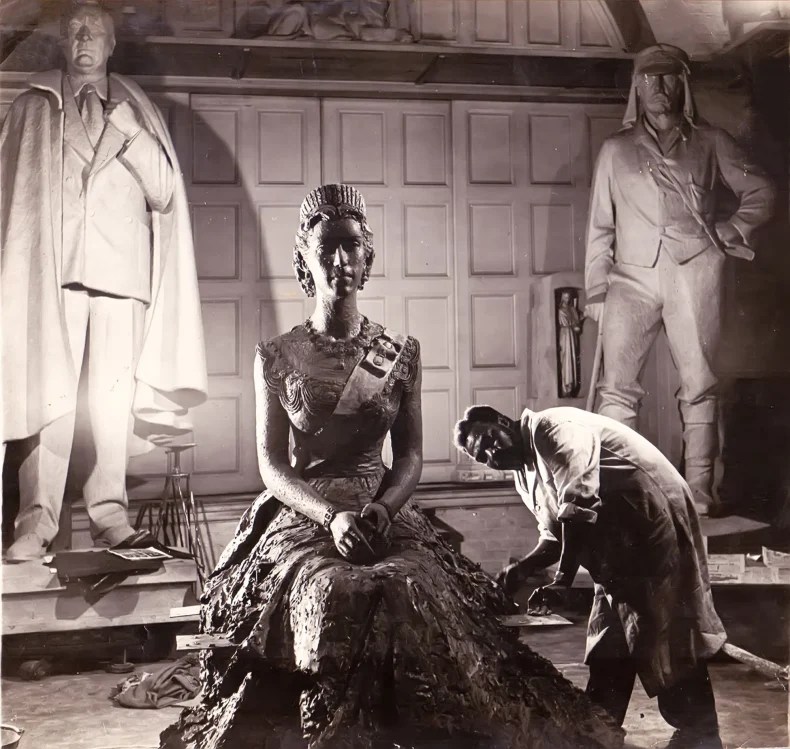
Enwonwu’s Portrait of the Queen provoked an extraordinary divergence of opinion. By this time, the artist was used to it. He knowingly provoked tabloid fury with his ostentatious lifestyle – flower pinned to his lapel, driving his American Packard through post-war London – while winning establishment acclaim. He had been awarded an MBE in 1955 and the royal commission brought with it extensive coverage on the BBC, membership of the Royal Society and a role as Art Advisor to the Nigerian government.
This month, Tate Modern opens the long-anticipated exhibition, ‘Nigerian Modernism’ (9 October–10 May 2026). In spite of its title, this landmark show makes it clear that looking at modernism in Nigerian art as a singular, coherent movement is as obvious a mistake as trying to conceive of a unified ‘modernism’ tout court. Rather, the exhibition demonstrates how more than 50 artists, represented by some 250 works spanning half a century, arrived at their own distinct answer to the question of what, exactly, modernity meant for and in Nigeria.
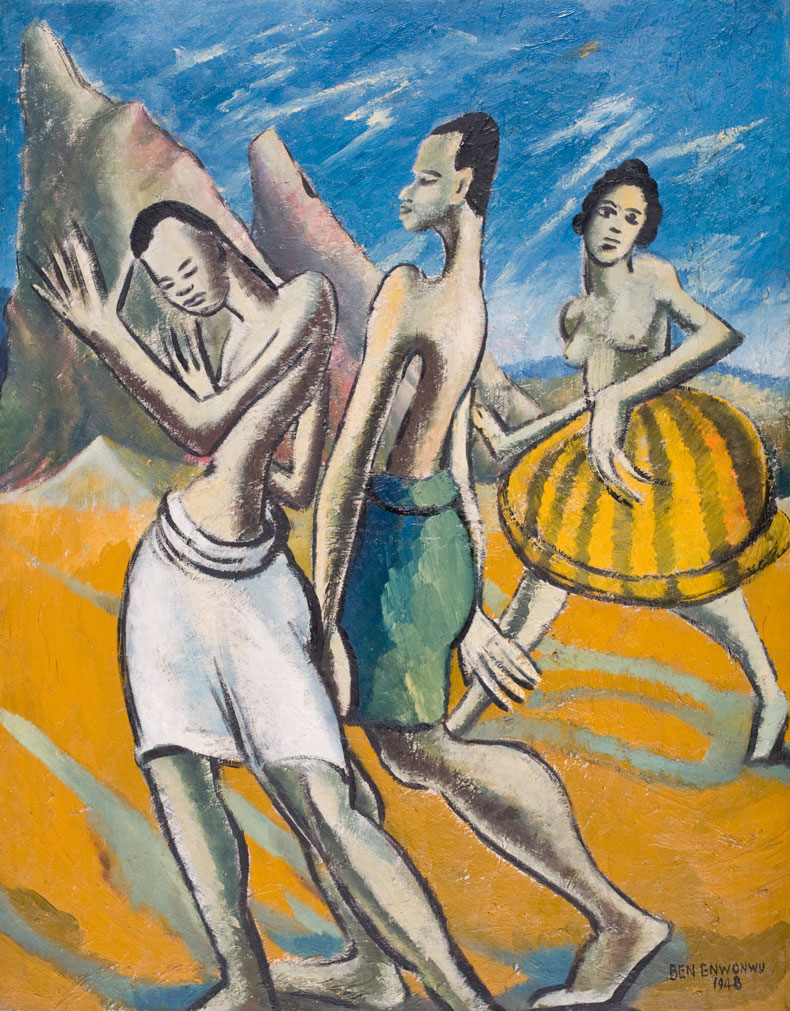
Fittingly, Enwonwu’s own role in the story is presented in a way that preserves the ambivalence it has always possessed. With the second room of nine in the exhibition devoted to his work, Enwonwu might appear – as some scholars have long insisted that he is – merely as a kind of bridging figure. In this reckoning, he took up the baton from the earliest pioneers of modern sensibility in Nigerian art and carried it forward but, hampered by the extent of his colonial education, he could only hand it on to a younger generation shaped by the independence struggle.
Yet Enwonwu’s career did not stop with Nigeria’s independence in 1960. It developed over the entire period considered in the exhibition, from the 1930s to his death in 1994. With more than 50 works, this is his most significant showing in London since the 1950s. What it suggests above all is that Enwonwu’s twists and turns mirrored those of the nascent Nigerian state. Like any master political operator, he learned how to play to different audiences simultaneously, while also defining his own positions on the role of art in politics (and vice versa). Like Picasso, he kept meticulous records of how his art and thought developed in pace with the changing world around him. Today, Enwonwu remains one of his era’s most eloquent guides to the complex and conflicting forces that defined it.
Benedict Chukwukadibia Enwonwu was perfectly placed to play different and not always compatible roles. He was born in 1917 in Onitsha, a cosmopolitan city on the eastern shore of the River Niger and thus the western fringe of traditional Igbo territory, which had been chosen as the colonial provincial headquarters. Enwonwu’s father, Emeka, was a locally renowned sculptor. His death in 1921 and the death in childhood four years earlier of Enwonwu’s twin brother, Jacob, were the key events of the artist’s young life. According to his principal biographer, Sylvester Okwunodu Ogbechie, he became introspective, preferring the company of the puppets he would craft out of plants and clay. His relatives diagnosed symptoms of agwu, an Igbo concept that attributed to him visionary access to the metaphysical realm which, if not channelled appropriately into creative practice, could spell deviancy.
At the age of 14, Enwonwu was selected for a new course at Government College, Ibadan, established with a view to training up a generation of Nigerian art teachers. Here he became the protégé of the Englishman Kenneth C. Murray, a figure whose influence on modern Nigerian art is as inescapable as it is now contested. For Murray, principles of European aesthetics, such as perspective, were viewed as corrosive to the creativity of his charges. Instead, he wanted to train them only in the techniques of Western pictorial art such as mixing paints and laying washes, rather than its subjects. Murray’s chief rival as a pedagogue, Aina Onabolu, contended instead that it was patronising to deny Africans the opportunity to learn from Western traditions; his own Reynolds-inspired portraits of Lagosian figures are on view at the Tate. It was Murray’s approach, however, that had the backing of the colonial government. No small irony, then, that when Murray’s specially selected group of five artists were displayed at the Zwemmer Gallery in 1937, William Rothenstein declared his satisfaction that London ‘should have real Africans doing African art rather than Europeans doing pseudo-African art.’
Looking at Enwonwu’s early works, it can be difficult to recapture both the British establishment’s impression of their ‘authenticity’ and the anecdotes of prominent modernists declaring their genius. (‘Why go on?’, Max Ernst was reported to have exclaimed despairingly at the Zwemmer.) Following Murray’s teaching, his watercolours are predominantly quaint genre scenes of everyday West African life. But their preoccupation with intricacy of pattern, on the one hand, and sinuosity of line on the other do call to mind both modernist experiments with flattening the picture plane and traditional Igbo uli aesthetics. They were, at any rate, something new.
There followed a spell as an art teacher in the Murray method in Benin City where Enwonwu found new sources of inspiration in the ancient kingdom’s aesthetic traditions. A solo exhibition in Lagos in 1943 brought him to the attention of the director of Shell Petroleum, who sponsored further training at the Slade in London. Enwonwu was not the Slade’s typical recruit – apart from the fact he was its first African student, he had a flourishing professional career yet only a teacher-training certificate to his name. He was ordered to take remedial drawing classes.
Enwonwu’s own view of his varied and very long education was straightforward: ‘My mind was open to learning all I could, but I was quite determined to sift away all the influences and use what was beneficial to me.’ He became just as good at knowing what was bad for him – when an article in Ebony in the late 1940s tried to yoke his vivid palette to the influence of Van Gogh, Enwonwu came up with a memorable riposte: ‘In the fierce sunlight of Nigeria, only the primary colours survive.’
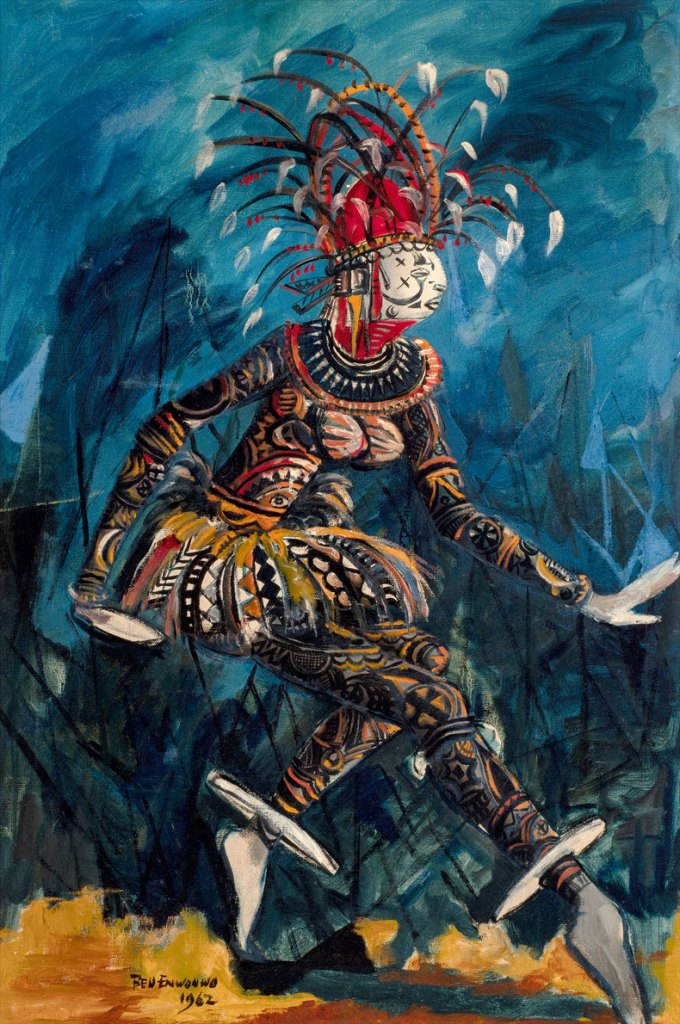
Survival seems always to have been an issue for Enwonwu. He was ‘bound’, he said, to express ‘the political aspirations of his time’ – and ‘for such expressions to be true, they must be an embodiment of the struggle for self-preservation’. By the time of his exhibition at the Marina Center in Lagos, 1949, he had developed a mature and distinctive style in both painting and sculpture. The Africa Dances series, begun in 1949, marked the beginning of a painterly obsession with the Onitsha-Igbo masquerade tradition that would last until the end of his life. He continued producing works with the title Africa Dances, while focusing in later years on masquerade characters, as in the series begun in the 1960s named after Agbogho Mmuo, the maiden spirit, or his works of the 1980s–90s depicting the male spirit Ogolo. His portrait sculptures in ebony or Indian mango wood exhibited a deep engagement with architectonic forms learned from African sculpture, which the British press considered to elevate him from the ‘pale copycat perversity’ of European artists looking at African art, and which gained him the patronage of Jacob Epstein.
Enwonwu also embarked on successful exhibition tours of the United States and developed a friendship with Léopold Sédar Senghor, the poet of Négritude and future president of Senegal. All of these influences were perhaps first fully harnessed by Enwonwu in Anyanwu (1954–55), one of his earliest sculptural masterpieces. Installed in front of the National Museum, Lagos, Anyanwu presents in bronze the sinuous, elongated form of a female figure. Her head is derived from the famous Benin portrait sculpture of Idia, the Queen Mother; her body is at the same time a reworking of an earlier Enwonwu painting, a response to the pan-African aesthetics of the Harlem Renaissance, an Igbo salutation to Anyanwu (the sun), and a Senghorian hymn to the Black feminine ideal. For Enwonwu, it symbolised ‘the rising nation’.
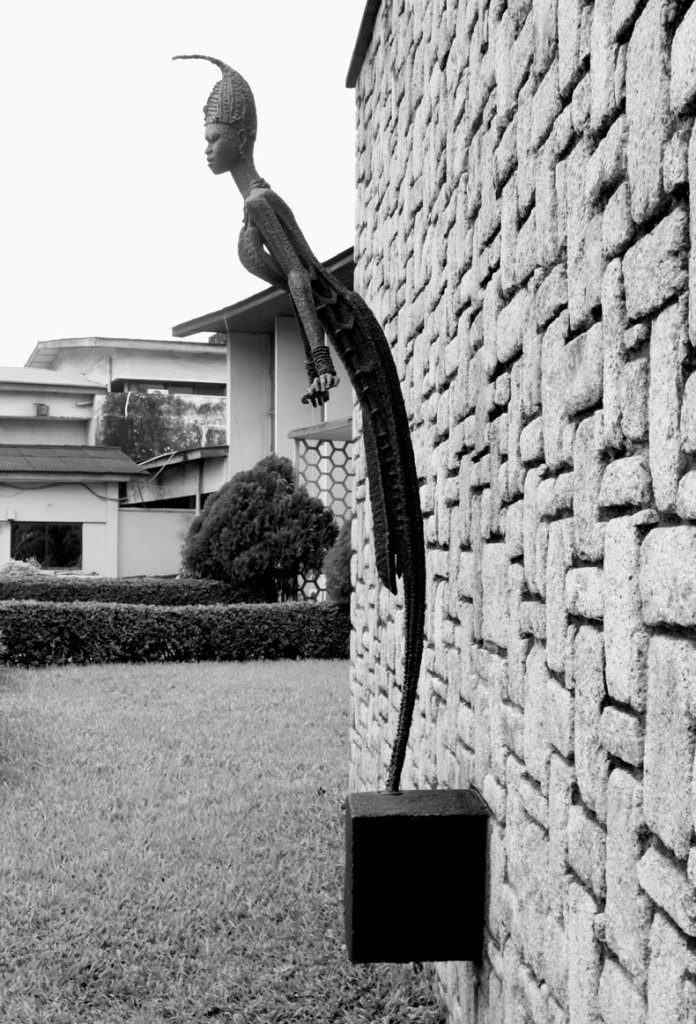
Life in the new nation, however, brought with it a new series of struggles – from within and without. At an exhibition in 1960 marking independence, Enwonwu was sidelined in favour of a new movement that had emerged from the Nigeria College of Arts, Science and Technology in Zaria. The Zaria Rebels, as they became known, promoted an aesthetic philosophy of ‘Natural Synthesis’, which found its most celebrated expression in Uche Okeke’s swirling abstract constructions, incorporating Igbo uli patterns. Their cause was taken up by the German-born critic Ulli Beier, who in his review of the exhibition emphasised Enwonwu’s training in London, denying its claim to be ‘authentically “Nigerian”’. Enwonwu railed against these upstarts as merely following the West ‘into the abstract jungle’: ‘To produce a good work of African painting or sculpture does not mean imitation of modern European artists – abstract art & what not; – nor the even worse kind of weakness in copying old African traditional art’.
Enwonwu’s attitude towards the Zarianists gradually softened – they were, after all, invested in the same project to ‘prove to the world that African Art can be […] continued’; he saw Beier, however, as the primary villain among a wave of interloping tastemakers. Beier went on to co-found the Mbari Club in Ibadan; edit its mouthpiece, Black Orpheus; and also initiate with Susanne Wenger the independent Osogbo School, which favoured Surrealist automatism and a Dubuffet-like privileging of the untaught artist. There were also Cold War undercurrents at play; while Enwonwu remained an impassioned voice for Nigerian non-alignment, Beier’s operations were accepting funding from the Congress for Cultural Freedom (CCF), a covert subsidiary of the CIA.
In his art, Enwonwu shifted towards ever-more prominent and ambitious political works. A monumental bronze statue of Nnamdi Azikiwe, revolutionary leader prior to independence and now the first Nigerian President, was installed in Onitsha in 1961. The same year he painted Going; described by Okwui Enwezor as an ‘exemplary’ instance of ‘the idea of cultural sovereignty and the uniqueness of postcolonial African modernity’, this three-metre-wide canvas presents a prodigious cast of characters drawn from West African masquerades alongside graceful, anonymous feminine figures, interlocking in complex architectonic configurations that lend them both the stasis of a carved frieze and the fluidity of an ethereal pageant. In 1964, he was commissioned to produce a bronze sculpture for the headquarters of the National Electric Power Authority in Lagos. Sango, named after the Yoruba thunder god, is a 14-foot, loincloth-clad figure. Rippling with muscles, his eyes are cast heavenward, while his features derive from a c. 13th-century bronze figure of an Ooni (king), one of the famous lost-wax castings of Ife, the ancient city to which the Yoruba trace their origins.
Sango is perhaps the most famous public sculpture in Lagos – a fitting emblem for Enwonwu’s fiercely held conviction that an independent Nigerian state could rise above ethnic rivalries. Clouds, however, were already gathering on the horizon. Enwonwu led the Nigerian delegation to Dakar in April 1966 for the First World Festival of Negro Arts – now recognised as the high-water mark of the first phase of African cultural nationalism, but also a moment when the cracks in the pan-African idealism of Négritude were showing. In January 1966, an attempted coup in which the Nigerian Prime Minister, Abubakar Tafawa Balewa, was assassinated, had brought ethnic tensions to boiling point, leading to the declaration of the independent Igbo Republic of Biafra the following year. Chinua Achebe described the ensuing three years of brutal civil war, in which the secession was eventually quelled with extensive British support, as a ‘cataclysmic experience that changed the history of Africa’. As an Igbo in a government position, Enwonwu was in jeopardy in Lagos; he fled to Onitsha until it was bombarded by Nigerian government forces, destroying much of his art collection, after which he escaped to London. After publicly questioning the secession and calling for a new Igbo leadership, he was branded a traitor back in Biafra.
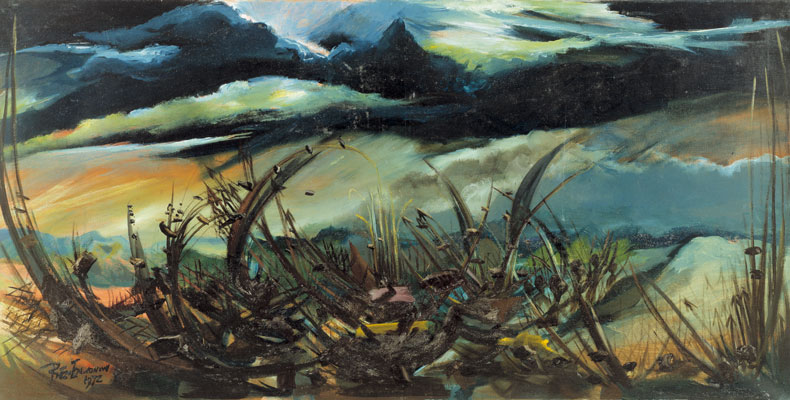
Enwonwu spoke of his decade-long series of portraits of wartime refugees, Children of Biafra (1966–76), as a kind of atonement for having failed to do more in the conflict. In a superb, brooding landscape on show at the Tate, Storm over Biafra (1972), he realised both an expression of elemental tragedy and a resounding call for national introspection. From the end of the conflict in 1970 until the end of his life, Enwonwu continued to express his belief in the potential of art to forge a multicultural, postcolonial Nigerian identity. His depictions of Igbo masquerades became ever more consummate in their essential rhythm, their harnessing of both modernist and African strategies of geometry, composition and colour to enact the spirituality of movement. Most significantly, after falling in love (unreciprocated) with the Yoruba princess Adetutu Ademiluyi, granddaughter of the Ooni of Ife, he painted her portrait in 1974. With her calm yet ambiguous glance back over her shoulder, wearing elaborate stately clothing and headdress, it is no surprise that Tutu – prints of which soon came to adorn homes throughout Nigeria – has been dubbed the African Mona Lisa. Seen in the Biafran context, it is also, as Ben Okri has written, ‘a symbol of the phoenix rising’.
Just before Enwonwu’s death in 1994 – an era of military juntas and civil unrest – Tutu was stolen. His statue of Queen Elizabeth also went missing sometime after independence and was recovered in the caretakers’ office at the National Museum in Lagos in 2000, the year after democracy had been reinstated. It was installed at the British Ambassador’s residence in 2018 ahead of the Prince of Wales’s visit, its first royal audience in 70 years. The same year, Tutu, having been rediscovered hanging in a London flat, went back on display in Lagos – a fitting symbol of a new era of cultural optimism and a willingness to revisit the struggles of Nigeria’s modernists, in which the Tate’s exhibition is the latest milestone. Even after his death, the artworks of Ben Enwonwu have not lost their uncanny ability to reflect Nigeria’s fortunes.
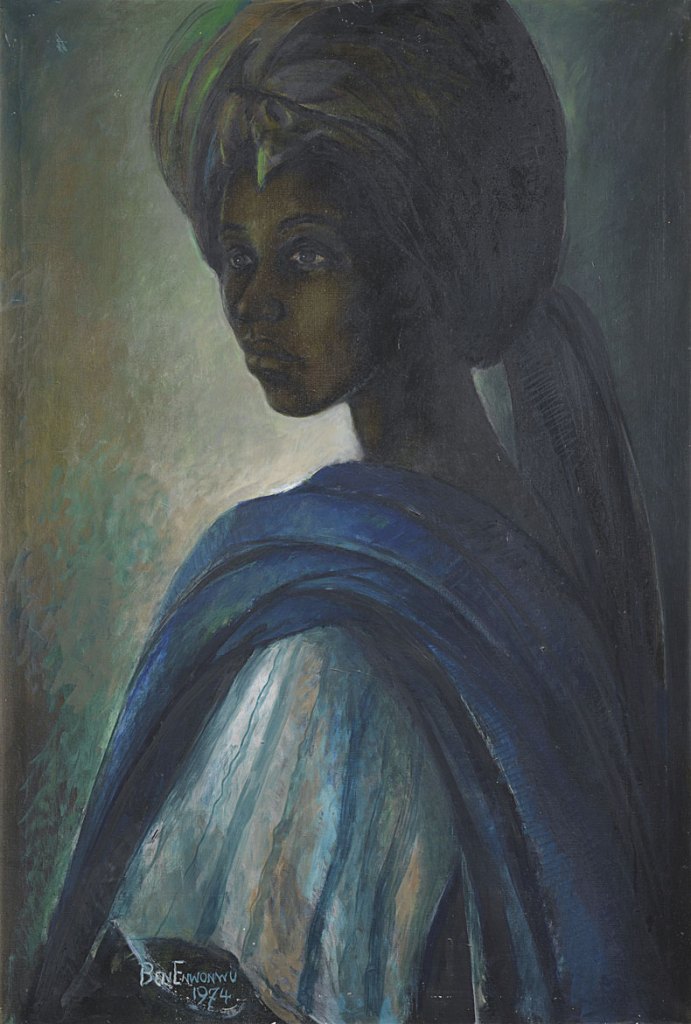
‘Nigerian Modernism’ is at Tate Modern, London, from 8 October to 10 May 2026.
From the October 2025 issue of Apollo. Preview and subscribe here.